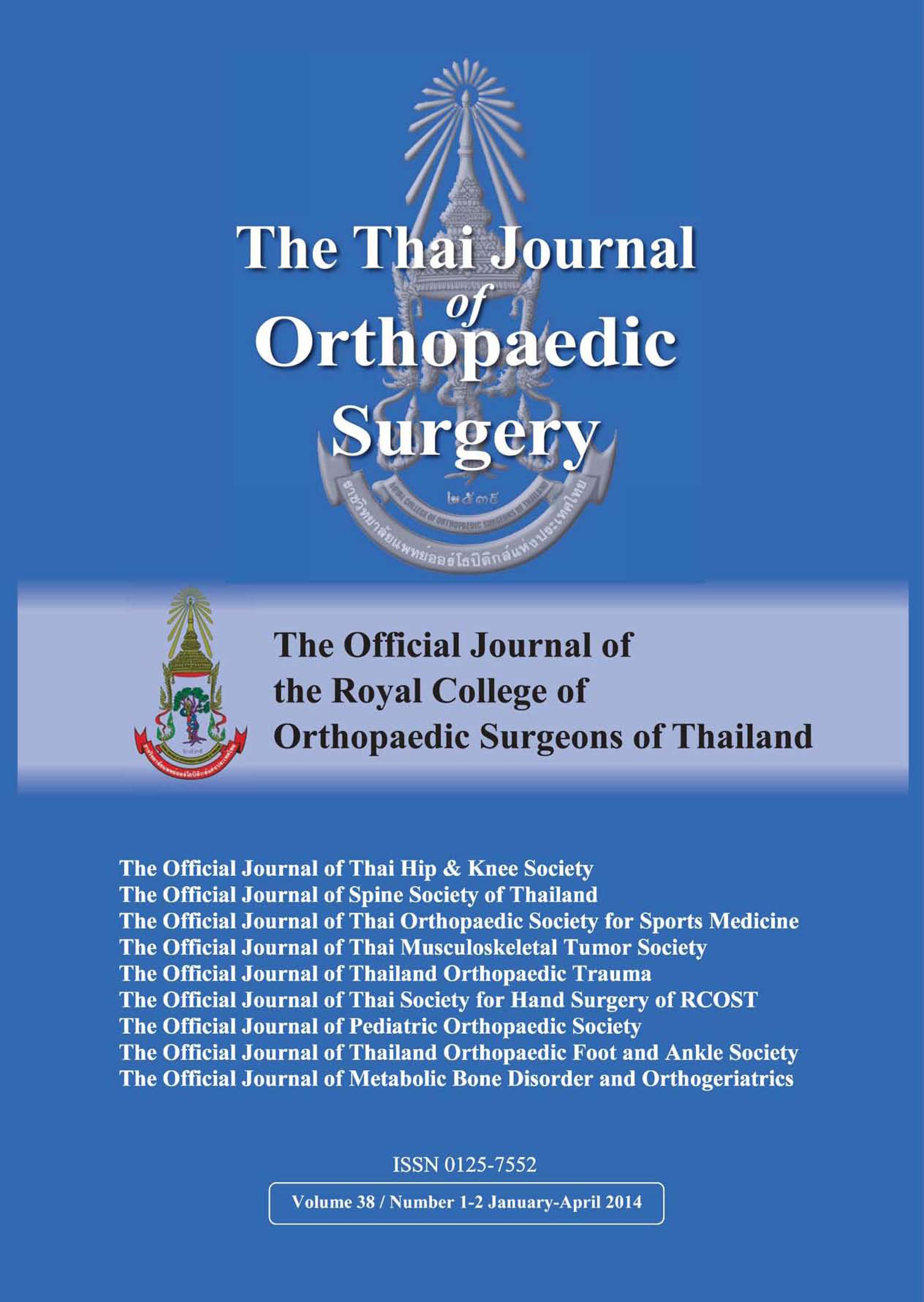Infrapatellar Branch of the Saphenous Nerve: A cadaveric study
Main Article Content
Abstract
Purpose: Total knee arthroplasty (TKA) is one of the most successful procedures and widely performed in orthopedic surgery. Among concerned complications of TKA, lateral skin numbness has been reported as a result of infrapatellar branch of the saphenous nerve (IPBSN) injuries which may affect the outcome and satisfaction of patients. The study on the distribution of the IPBSN related to anatomical landmarks in TKA may provide knowledge to avoid or minimize injury to this nerve. The aim of this study was to examine the distribution of IPBSN in relation to anatomical landmarks used for skin incision in TKA.
Methods: This study was a descriptive study on 15 soft cadaveric adult knees. The infrapatellar branch of the saphenous nerve was identified and its distribution was studied. The exit point of the IPBSN from adductor’s canal was examined and reported in relation to the sartorius muscle. The distance from the IPBSN to the medial border of the patella at the mid patellar bone and the vertical distance from the main branch of the IPBSN to the inferior patellar pole when the nerve crossed the knee midline were measured.
Results: We observed that the distribution of the IPBSN traveled from proximal toward distal direction and from the medial side across the knee midline toward the lateral side. All branches of the IPBSN crossed the knee midline between the superior patellar pole and the tibial tubercle with variation of the branching pattern, including a single nerve in 20 % (3/15), 2 branches in 67% (10/15), and 3 branches in 13 % (2/15). There were 2 patterns of exit point of the IPBSN from adductor’s canal related to the sartorius, including posterior to the muscle in 27% (4/15) and piercing through the muscle in 73% (11/15). The average distance of the nerve from the medial border of the patella at the mid patellar bone was 6.7 ± 0.99 cm (range 4.8 – 8.8 cm) and the average vertical distance from the inferior patellar pole and the main branch of the nerve was 2.4 ± 0.85 cm. (range 1.1 – 3.0 cm).
Conclusion: The distribution of IPBSN traveled from proximal toward distal direction and from the medial side across the knee midline toward the lateral side with variation of pattern. As all branches of IPBSN passed the knee midline between the upper patellar pole and the tibial tubercle, our study implied that the IPBSN injury related to skin incision between standard and less invasive skin incisions in TKA might not be different.
Article Details
References
2. Johnson DF, Love DTT, Love RT, Lester K. Dermal hypoesthesia after total knee arthroplasty. Am J Orthop 2000; 29: 863-6.
3. Hopton BP, Tommichan MC, Howell ER. Reducing lateral skin flap after total knee arthroplasty. Knee 2004; 11: 289-91.
4. Tennent TD, Birch NC, Holmes MJ, Birch R, Goddard NJ. Knee pain and the infrapatellar branch of the saphenous nerve. J R Soc Med 1998; 91: 573-5.
5. Mochida H, Kikuschi S. Injury to infrapatellar branch ofsaphenous nerve in arthroscopic knee surgery. Clin Orthop 1995; 320: 88-94.
6. Ebraheim NA, Mekhail AO. The infrapatellar branch of the saphenous nerve: An anatomic study. J Orthop Trauma 1997; 11: 195-9.
7. Kartus J, Ejerhed L, Eriksson BI, Karlsson J. The localization of the infrapatellar nerves in the anterior knee region with special emphasis on central third patellar tendon harvest: a dissection study on cadaver and amputated specimens. Arthroscopy 1999; 15: 577-86.
8. Berg P, Mjoberg B. A lateral skin incision reduces peripatellar dysaesthesia after knee surgery. J Bone Joint Surg Br 1991; 73: 374-6.
9. Sundaram RO, Ramakrishnan M, Harvey RA, Parkinson RW. Comparison of scars and resulting hypoaesthesia between the medial parapatellar and midline skin incisions in total knee arthroplasty. Knee 2007; 14: 375-8.
10. Subramanian S, Lateef H, Massraf A. Cutaneous sensory loss following primary total knee arthroplasty. A two years follow-up study. Acta Orthop Belg 2009: 75: 649-53.


